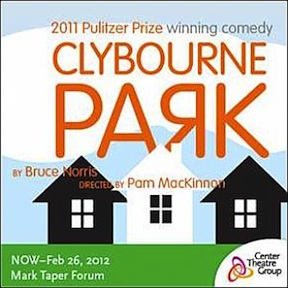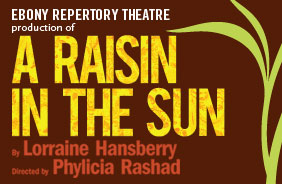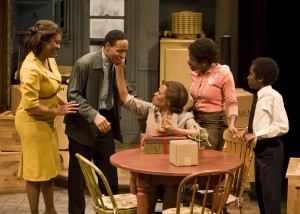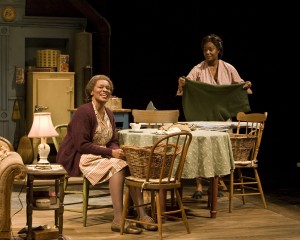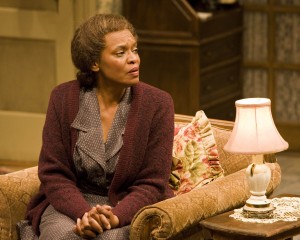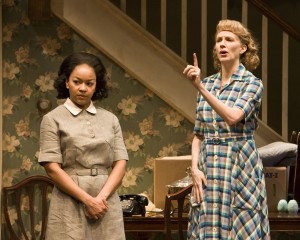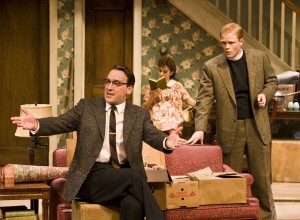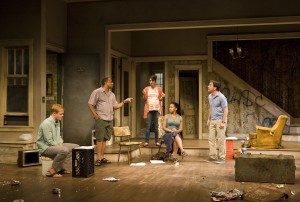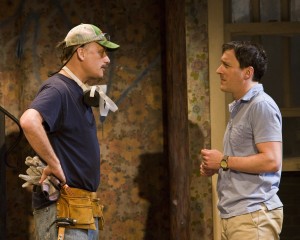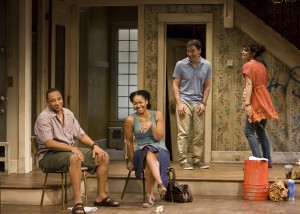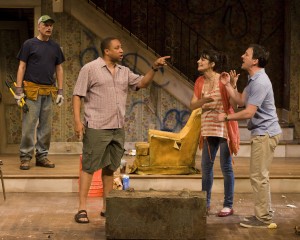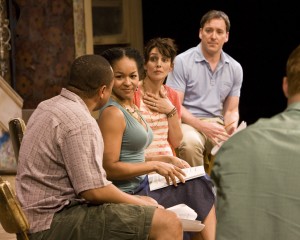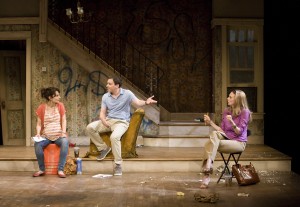THE CLYBOURNE CONNECTION
There are two reasons to revive a play. One: to see if the play has retained its power over the years. And two: to look at the play afresh, with eyes that see now what we may not have seen when the play in question was first produced. The beauty of Phylicia Rashad’s simple, direct, and heartfelt revival of Lorraine Hansberry’s prize-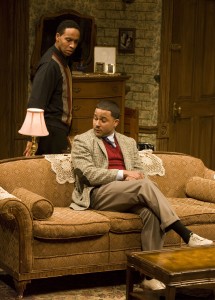 winning 1959 play A Raisin in the Sun is that it proves incontestably that the play’s strengths have not diminished with time and that, seen anew from the perspective of a woman, the play may finally be truer to the playwright’s own unique vision. This is, after all, a play about strong women.
winning 1959 play A Raisin in the Sun is that it proves incontestably that the play’s strengths have not diminished with time and that, seen anew from the perspective of a woman, the play may finally be truer to the playwright’s own unique vision. This is, after all, a play about strong women.
It is the story of an African-American family, the Youngers, who live on the Southside of Chicago and yearn to make something better of their lives and, when the Younger patriarch dies and leaves an insurance policy worth $10,000 (proving that sometimes a person is, in our culture, disposable, and, therefore, worth more dead than alive), Mama Lena Younger puts a down payment on a house, a house that happens to be smack in the center of a white community, Clybourne Park. The buying of the house puts a serious dent in the plans of Walter Lee Younger, who sees the money as a good way to have his own business and cease being a limousine driver.
Walter Lee is a decent man, but sometimes it is the decent men who get screwed with, which is precisely what happens to the well-meaning but hapless Walter Lee. There is no need to know more about the plot; the plot works itself out brilliantly and, in its way, triumphantly, although, given the situation of an African-American family, in Chicago’s Southside in 1959, moving into a white community, we are left – as are the Youngers – with a question mark. What will they have to endure in their efforts to move forward?
That the play does not seem dated is, in its way, a trifle saddening. Plays written fifty years ago on incendiary subjects should, by now, prove to be of their own time, not of ours. We should have moved farther along than we have. And, of course, we have moved a great distance since then, and yet Race, as a subject, is still unsettling. Racism, like anti-Semitism, always rears its ugly head, even when – or perhaps especially when – the hellish ways of the world should have taught us that we must never move backward. But the move forward is always a struggle for the victims of society who stubbornly and rightfully refuse to continue to be victimized.
It’s the eternal verities that keep A Raisin in the Sun from seeming stale or dated. These are real flesh-and-blood people, seen whole and with great empathy and, best of all, with humor. Hansberry lets us laugh at her people, even if they don’t find the laughter in themselves. And it’s precisely the kind of laughter we encounter in our own living rooms. These characters trip over themselves, hurt each other, and still are filled with love for each other. They are never coarsened or sentimentalized in order to be made more theatrical; this is good theater because these are people we want to spend time with, people we recognize, people whose desires mirror our own.
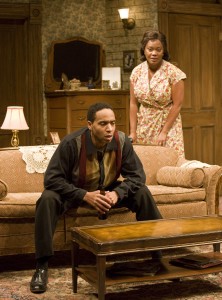 Anyone who saw the original production is apt to feel, as this reviewer does, that it can never be surpassed. The cast was so good (Sidney Poitier, Ruby Dee, Claudia McNeill, Louis Gossett, Ivan Dixon, the great Diana Sands, John Fiedler) that, when the film version was made, the entire Broadway cast brought the play from stage to screen, and that historic film is readily available. So this, then, is a production for a new generation. The cast is solid and uniformly good. And when Kim Staunton, as Lena, brings the wrath of God down upon Walter Lee for squandering the money her husband worked so hard for, one feels as if one has seen a tornado coming and, unable to find a way out of its path, is left, in its aftermath, trembling and weeping. Ms. Staunton makes Lena more real than she has ever seemed before. It is ironic that Staunton is the only cast member who didn’t create the part in this Ebony Repertory Theatre production. And Amad Johnson, as a young African radical, delivers the one speech that still vibrates exactly as it did over fifty years ago with panache and dazzling clarity; it is perhaps because its truths have both taken root and remained relevant.
Anyone who saw the original production is apt to feel, as this reviewer does, that it can never be surpassed. The cast was so good (Sidney Poitier, Ruby Dee, Claudia McNeill, Louis Gossett, Ivan Dixon, the great Diana Sands, John Fiedler) that, when the film version was made, the entire Broadway cast brought the play from stage to screen, and that historic film is readily available. So this, then, is a production for a new generation. The cast is solid and uniformly good. And when Kim Staunton, as Lena, brings the wrath of God down upon Walter Lee for squandering the money her husband worked so hard for, one feels as if one has seen a tornado coming and, unable to find a way out of its path, is left, in its aftermath, trembling and weeping. Ms. Staunton makes Lena more real than she has ever seemed before. It is ironic that Staunton is the only cast member who didn’t create the part in this Ebony Repertory Theatre production. And Amad Johnson, as a young African radical, delivers the one speech that still vibrates exactly as it did over fifty years ago with panache and dazzling clarity; it is perhaps because its truths have both taken root and remained relevant.
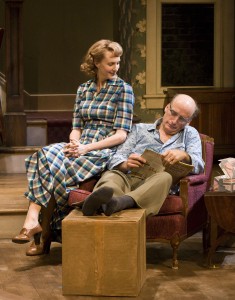 It was clever (and cost-effective) on the part of the Center Theatre Group to bring us this ready-made production in conjunction with its production of Bruce Norris’s Clybourne Park, although the connection between the two, while specific (I’ll get to it in a minute), is fairly tenuous. It might be interesting to see the plays in tandem, but it is not really necessary. Neither is it necessary to read Isabel Wilkerson’s The Warmth of Other Suns: The Epic Story of America’s Great Migration, but, because the subject reaches beyond the matter of the plays themselves, it certainly can’t hurt. It’s a way of connecting the dots between one work and another, between one lifetime and another. And it is fascinating to see that both the Wilkerson book and the Norris play have been awarded major prizes in the post-Obama age. That fact alone keeps A Raisin in the Sun alive. It would, of course, have been more fortuitous if the revival of RAISIN matched, in brilliance, the production of Clybourne Park. If, as some people always tell us, context is everything, then it must be admitted that Raisin pales beside Clybourne.
It was clever (and cost-effective) on the part of the Center Theatre Group to bring us this ready-made production in conjunction with its production of Bruce Norris’s Clybourne Park, although the connection between the two, while specific (I’ll get to it in a minute), is fairly tenuous. It might be interesting to see the plays in tandem, but it is not really necessary. Neither is it necessary to read Isabel Wilkerson’s The Warmth of Other Suns: The Epic Story of America’s Great Migration, but, because the subject reaches beyond the matter of the plays themselves, it certainly can’t hurt. It’s a way of connecting the dots between one work and another, between one lifetime and another. And it is fascinating to see that both the Wilkerson book and the Norris play have been awarded major prizes in the post-Obama age. That fact alone keeps A Raisin in the Sun alive. It would, of course, have been more fortuitous if the revival of RAISIN matched, in brilliance, the production of Clybourne Park. If, as some people always tell us, context is everything, then it must be admitted that Raisin pales beside Clybourne.
And that’s because Clybourne Park is a knockout. Leaving the theater, I was reminded of Kenneth Tynan’s review of Gypsy, in which he said that it tapered off from perfection in the first act to mere brilliance in the second. To borrow the thought, the first act of Clybourne Park is a masterpiece; the second act, merely brilliant. This is just about the most powerful and provocative theatrical experience I’ve had watching a new American play since Tony Kushner’s Angels in America. I became a fan of Norris when I saw his The Pain and the Itch, and I’ve been waiting patiently for him to overcome the withering dismissal of that play in the New York Times and finally get the recognition he deserves as a major new playwright.
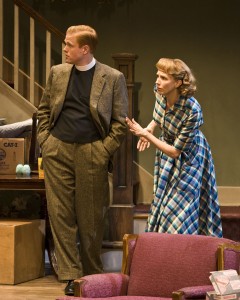 The first half of Norris’s new play takes place in the house that the Younger family are about to move into, on the last day that its present occupants – Russ and Bev – will be there. They are haunted by their son’s suicide and can no longer live with the memory, including a secret they literally bury under a tree in the backyard. Russ is a good liberal and so, despite the fears expressed by Karl Linder (the one character who appears in both Raisin and Clybourne) about a black family moving into their community, Russ stands up to Linder, and the rest, as they say, is history. The sense of time is made palpable by the pungency of its writing (boy, does Norris have fun with language!), the depth of its characterizations (though dressed to look like stock characters in a 50s’ TV series, they are anything but stock characters), but, most of all, by the urgency of its arguments, and by the fluidity with which it moves from moment to moment, creating, with each movement, a landscape of regret and frustration, embodying an emotionalism that is too raw to be fully expressed but which, tacitly, sums up an entire generation. And it is, for reasons that aren’t always evident, hilariously funny. The laughter in Clybourne Park is sometimes cruelly arrived at; it hasn’t the undercurrent of familial warmth that pervades Raisin. It is a different time. These are different people. If the Youngers expressed hope for the future, Russ and Bev live with the despair of the past. The view is darker and slightly sour and is telling about the ugliness of the time in which it takes place, yet to curiously bracing comic effect.
The first half of Norris’s new play takes place in the house that the Younger family are about to move into, on the last day that its present occupants – Russ and Bev – will be there. They are haunted by their son’s suicide and can no longer live with the memory, including a secret they literally bury under a tree in the backyard. Russ is a good liberal and so, despite the fears expressed by Karl Linder (the one character who appears in both Raisin and Clybourne) about a black family moving into their community, Russ stands up to Linder, and the rest, as they say, is history. The sense of time is made palpable by the pungency of its writing (boy, does Norris have fun with language!), the depth of its characterizations (though dressed to look like stock characters in a 50s’ TV series, they are anything but stock characters), but, most of all, by the urgency of its arguments, and by the fluidity with which it moves from moment to moment, creating, with each movement, a landscape of regret and frustration, embodying an emotionalism that is too raw to be fully expressed but which, tacitly, sums up an entire generation. And it is, for reasons that aren’t always evident, hilariously funny. The laughter in Clybourne Park is sometimes cruelly arrived at; it hasn’t the undercurrent of familial warmth that pervades Raisin. It is a different time. These are different people. If the Youngers expressed hope for the future, Russ and Bev live with the despair of the past. The view is darker and slightly sour and is telling about the ugliness of the time in which it takes place, yet to curiously bracing comic effect.
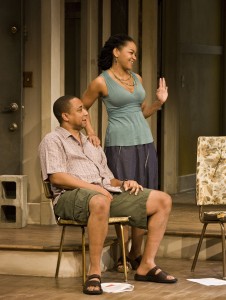 In the second act, it is fifty years later. The house in Clybourne Park is about to be razed; if, as Alexis De Toqueville claimed, American history is the history of private property, we are now seeing that the Younger family did have an impact, that the community became one in which blacks and whites have not only learned to live together but ultimately changed the landscape itself, and, now, because all things that go around turn around, a nice young liberal Jewish couple – Steve and Lindsey – are about to tear the house down and build themselves a very different and much larger house’¦but one in which their children will be raised in an integrated community. However, good intentions cannot hide basic prejudices, as we discover when the community board meets to discuss what Steve and Lindsey can and cannot do in re-building. What ensues is one of the most riotous confrontations about race and gentrification you can imagine, all while a handyman is literally unearthing the secret that has been buried in the backyard for fifty years (metaphors abound, but subtly so for the most part). While I may cavil about how conveniently things come to an end, it is a minor complaint in face of the play’s achievement. Norris has taken a post-modern look at the comedy of manners and refashioned it in much the same way that Annie Baker turned Chekhovian comedy on its head in her Circle Mirror Transformation.
In the second act, it is fifty years later. The house in Clybourne Park is about to be razed; if, as Alexis De Toqueville claimed, American history is the history of private property, we are now seeing that the Younger family did have an impact, that the community became one in which blacks and whites have not only learned to live together but ultimately changed the landscape itself, and, now, because all things that go around turn around, a nice young liberal Jewish couple – Steve and Lindsey – are about to tear the house down and build themselves a very different and much larger house’¦but one in which their children will be raised in an integrated community. However, good intentions cannot hide basic prejudices, as we discover when the community board meets to discuss what Steve and Lindsey can and cannot do in re-building. What ensues is one of the most riotous confrontations about race and gentrification you can imagine, all while a handyman is literally unearthing the secret that has been buried in the backyard for fifty years (metaphors abound, but subtly so for the most part). While I may cavil about how conveniently things come to an end, it is a minor complaint in face of the play’s achievement. Norris has taken a post-modern look at the comedy of manners and refashioned it in much the same way that Annie Baker turned Chekhovian comedy on its head in her Circle Mirror Transformation.
And this happens to be a glorious production. The design elements – Daniel Ostling’s set, which sees 406 Clybourne Street through two distinct states of disarray; Allen Lee Hughes’s evocative lighting of the first act and the harsh glare he has imposed upon the second; Ilona Somogyi’s costumes, which pinpoint two different eras so beautifully; Charles Lapointe’s wigs, which are equally convincing, especially the rightness of Bev’s tight curls; John Gromada’s effective sound – are all fine examples of skilled professionalism. And this is the best ensemble I’ve seen on the Mark Taper Forum in years. There isn’t a single performance (in this instance, each actor plays two entirely different characters) that doesn’t seem spot on. The relaxed intensity of Frank Wood’s Russ (if you cannot imagine that one can be both relaxed and intense, you must see this performance) dominates the first act, and the fact that he imbues the minor role of the handyman with such humanity in the second reminds one of how quickly an actor can transform himself, making each character sharply different from the other without losing nuance in either.
And this is true of everyone. Jeremy Shamos is so despicable as Karl Linder and so winning as Steve, it is hard to believe it is the same actor playing the two parts. Crystal A. Dickinson and Damon Gupton do not hide their real feelings as the maid and her husband in the first act, and they are just as wonderful as the black board members of the second; Ms. Dickinson tells a joke in the second act that is so blatantly racist as to make one gasp, even as one laughs hysterically. Christina Kirk’s Bev is all hard edges with a lingering softness at the center, and is just as edgy in a less restrained way as a no-nonsense member of the board. Annie Parisse and Brendan Griffin, both excellent, round out this perfect cast.
Pam MacKinnon, who directed, gets the lion’s share of the credit for helping her actors deliver such fine-tuned performances, and for digging deep into the play’s recesses, finding nuggets of theatrical gold, and bringing them to the foreground. (One niggling comment: Ms. MacKinnon never seems to have watched rehearsals from the left side of the theater, since she keeps placing her actors in one strategic position that obscures a good deal of the upstage action. When one is present at an event that offers so much bounty, one wants it to be without flaw.)
I am excited that Clybourne Park is moving to Broadway, despite the possibility of its derailment when Scott Rudin pulled out of producing it (because Norris, who is also an actor, turned down a role in a television series Rudin is producing). Imagine putting a serious artist’s career on hold for turning down a part that so many other actors can play. So for now, at least, we have in our midst a play that, in a few months, people will be traveling to New York to see. Here it is, right now, right here, where we live. Those who miss it should not think of themselves as being seriously interested in the future of the theater.
photos by Craig Schwartz
Clybourne Park
Mark Taper Forum
Music Center, 135 N. Grand Ave.
Tues-Fri at 8; Sat at 2:30 & 8; Sun at 1 & 6:30
ends on February 26, 2012
for tickets, call 213.628.2772 or visit CTG
A Raisin in the Sun
Ebony Rep at the Kirk Douglas Theatre
9820 Washington Blvd. in Culver City
Tues-Fri at 8; Sat at 2 & 8; Sun at 1 & 6:30
ends on February 19, 2012
for tickets, call 213.628.2772 or visit CTG
